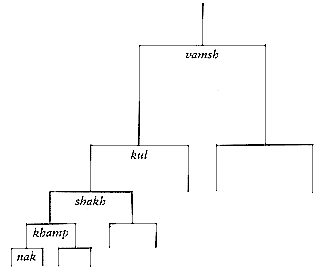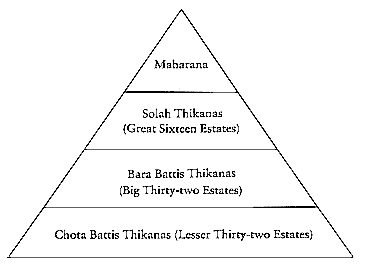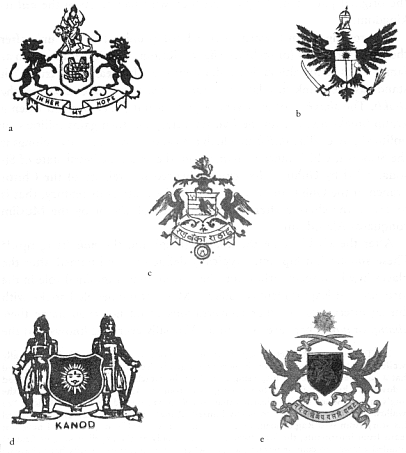Genealogy and Identity
Rajputs are keenly conscious of their genealogy, certain divisions within which are highly important features in the construction of personal identity. These segmentary kinship units locate the Rajput in contexts of family history and locality. The largest kinship unit within the Rajput jati (caste; literally, type or genus) is the vamsh (very roughly translatable as family in its broadest sense). In Rajasthan there are three great vamsh : sun, moon, and fire.[5] Rajputs understand themselves to be descended from these sacred phenomena (figs. 8, 9, 10). The vamsh to which the ruling family of Mewar belongs is the solar family, this identification being succinctly made in the Udaipur coat of arms, in which appears a great sun with a stern mustached visage. It is prominently displayed above the great central entrance to the City Palace.
[3] Ibid.
[4] A member of the royal family of Mansa (a small Rajput state) recalls that among the values stressed were the ideas of "generosity in victory, keeping your standard flying even in defeat," and so forth (Charles Allen and Sharada Dwivedi, Lives of the Indian Princes [London: Century Publishing, 1984], 53).
[5] Respectively, Suryavamsh, Candravamsh, and Agnivamsh. Elsewhere in India there are other lines, notably the sage (Rishivamsh) and snake (Nagvamsh), from which Rajasthanis sometimes take wives.

8.
Rajput genealogical chart.
Encompassed by each individual vamsh are kul s, smaller kinship units.[6] Again, the closest English equivalent to kul is family, but in a more restrictive sense than the vamsh . The term is not, however, particularly narrow: kul s comprise many generations and link present to past over hundreds of years.[7] Examples of kul s belonging to the solar vamsh are the Rathaur kul of Marwar, whose capital was Jodhpur, and the Kachvaha kul of Jaipur—both prominent kul s in Rajasthani history.[8]
Each Rajput kul traces its origin to a heroic ancestor, who typically left a homeland ruled by an older male relative or conquered by a foreign invader. Udaipur's royalty belongs to the Guhil kul , which was established by a colorful character named Guha after his father's kingdom
[6] Examples of other kul s include—the solar vamsh : Bumdela kul ; the lunar vamsh : Jadav, Tumvar, and Gaur kul s; the fire vamsh : Cauhan, Solamki, Pamvar, and Pratihara kul s (Norman Ziegler, "Action, Power, and Service in Rajasthani Culture" [Ph.D. diss., University of Chicago, 1973], 39 and passim).
[7] The Rajput kul in Rajasthan bears little resemblance to the shallow Nepali kul described by Bennett (Dangerous Wives , 18–21). In theory the Rajput kul s number thirty-six, all considered ancient (there is controversy about the constituents of this list; see Ziegler, "Action Power," 3). Whereas some of the myriad kul s in Nepal consist of only the members of one household, in Rajasthan fragmentation is assumed to occur at the level of kinship subgroups (shakh, khamp , etc.). Legitimacy as a Rajput is often considered questionable if identification with one of the thirty-six kul s cannot be established.
[8] Like the Sisodiyas belonging to the solar kul , they claim to be descended from the great Ram, hero of the Ramayan , himself a scion of the sun.

9.
Chart of Mewar thikana s.
in what is now Gujarat was destroyed by enemies in the sixth century.[9] According to legend, Guha was born after his father's death. His mother, who had been on a religious pilgrimage, was informed of the conquest as she was returning home. Shortly afterward, she took refuge in a cave to deliver her son and, after entrusting him to a Brahman, became a sati . Because of his unusual place of birth, the boy became known as Guha (cave), from which the patronymic Guhil was derived. Guha grew up in a forested area populated by members of the Bhil tribe. Enormously popular, he was eventually elected king of the Bhils at Idar (also in Gujarat). He was officially invested with royal authority when a Bhil cut his own finger and with his blood applied to Guha's brow the red mark (tika ) of sovereignty.
Guha becomes the first sovereign of the line that is established in the fortress of Chitor after ten generations, according to tradition. That feat is performed by the legendary Bappa Rawal, whom contemporary Rajputs often name as the "founding father" of the kingdom of Mewar.[10]
[9] Tod's dating (Annals and Antiquities 1:71) comports with the genealogical record at the Udaipur City Palace. On the evidence for such a date, see Ram Vallabh Somani, History of Mewar (Jaipur: C. L. Ranka, 1976), 33–34.
[10] Bappa (child) is a nickname and Rawal (king) is his title. Tod and Ziegler date Bappa's ascension to the mid-eighth century (Tod, Annals and Antiquities 1:71, 188; Ziegler, "Action, Power," 115); the Udaipur City Palace record and Somani (Mewar , 43–44) concur. At the top of the stairs Bappa Rawal's picture greets visitors as they enter the Udaipur City Palace Museum.

10.
State crests with kuldevi and vamsh insignias.
a , Ad Mata (the Jhala kuldevi ); b , c , kite forms of Naganecha Ji (the Rathaur kuldevi );
d , e , suns indicating Suryavamsh descent.
Like Guha, Bappa Rawal was born after his father was slain and raised in the hills by a Brahman.[11] He grew up to become a precocious young prince (tricking hundreds of naive maidens into marrying him) and eventually managed to ingratiate himself with the Mori ruler of Chitor, whom he later deposed in a coup. Hence whereas Guha is considered
[11] This repetition of mythical detail tends to meld or conflate the personalities and histories of the two heroes in the minds of many Rajputs today.
the original patriarch, Bappa is credited with having given the kul its kingdom.
Progressing down toward smaller kinship units, the next unit after the kul is the shakh (branch) (see fig. 8). Rajput genealogies are given as family trees. Thus although kul does not literally mean "tree trunk," it stands as the trunk in relation to the largest unit it encompasses, the shakh . The shakh is often a very important unit; it is founded when a group breaks away from the kul , relocates, and then gains military or political power. The shakh to which the Udaipur royal family belongs is the Sisodiya, which takes its name from the small medieval state of Sisoda, ruled by Guhils.[12] Its scions inherited sovereignty of the Chitor branch of the Guhils in the early part of the fourteenth century, that is to say in the chaotic aftermath of the sack of Chitor by the Muslim conqueror Ala-ud-din.[13]
After the shakh come the khamp (twig) and the nak (twig tip).[14] These smaller kinship units, typically defined by and named after the places in which their earliest members lived, play a minimal role in the formation of Rajput identity today.[15] Many of the people I spoke with during interviews or other conversations could not even name their khamp or nak . There are exceptions. Virtually everyone knows that the
[12] Tod gives alternate etymologies for the term Sisodiya. In one, the king accidentally swallowed a piece of meat in which there was a gadfly. To cure him a physician ordered that a cow's ear be cut off; disguising it in cloth, he attached a string to it and dangled it down the king's throat. It lured the gadfly from the king's stomach back out the king's mouth. When the king learned that cow flesh had passed his lips, he decided "to swallow boiling lead (seesa)" to purify himself (Annals and Antiquities 2:564). I heard this story from two Rajput men. In Tod's other version (1:176 n. 3), which I have not heard from informants, the king (whom Tod cites only as the expelled king of Chitor) founded a town "to commemorate the spot, where after an extraordinarily hard chase he killed a hare (sussoo)." The historical origins of the founding of this kingdom remain obscure.
[13] On genealogy at Sisoda and Sisodiya ascendance see ibid. 1:216; and Dasaharatha Sharma, Rajasthan through the Ages (Bikaner: Rajasthan State Archives, 1966), 672–73. Rajputs often anachronistically name Bappa Rawal as the founder of the Sisodya dynasty because they see acquisition of Chitor as the start of the rule that the Sisodiyas have enforced for centuries. Ziegler also does this ("Action, Power," 115).
[14] On Rajput kinship segmentation see Ziegler, "Action, Power," 36–58; and Brij Raj Chauhan, A Rajasthan Village (Delhi: Vir Publishing House, 1967), 50–56. Other descriptions are those of Richard Fox, Kin, Clan, Raja, and Rule (Berkeley: University of California Press, 1971); and Adrian Mayer, Caste and Kinship in Central India (Berkeley: University of California Press, 1970). But these do not accurately describe the system of kinship segmentation employed by Rajasthani Rajputs.
[15] These lesser units were important in medieval times when they were smaller and had internal political solidarity (Ziegler defines the "middle period" as eighth through seventeenth centuries ["Action, Power," 47]). The lesser unit names often derive from their original locales: thus the Mertiya Rathaurs belong to the khamp (the twig from Merta), though many Mertiyas, including those of Ghanerao, a prominent Mewar thikana , have for centuries lived away from Merta.
khamp for the Udaipur royal family is the Ranavat, which is appropriately named for it is the khamp from which the future king (rana ) is chosen when the royal family fails to produce an heir and so must adopt. This fact is significant because of the seven most recent Maharanas, only the current one was not adopted.
Of all the units mentioned, those that play the largest role in defining Rajput identity today are the kul and the shakh . Lesser units are too narrowly fixed, and the vamsh is too inclusive and remote a category to hold much meaning for individual members.[16] The kul 's importance is linked to the fact that Rajputs generally regard it as the unit of exogamy. This is interesting because reviewing the medieval archives, scholars have found that intra-kul marriages were actually allowed if kul members belonged to different gotras (the gotra is a rather hazily defined group of people who claim spiritual descent from a common Vedic sage). Norman Ziegler finds that in practice this problematic unit is generally identical to the khamp .[17] Rajputs today, however, both say that one should not marry within one's kul and in fact practice kul exogamy. Of the marriages I recorded (the marriages of respondents and those of their parents), there was not a single instance of intra-kul alliance.
Apart from the practical matter of exogamy, the kul has importance because theoretically at least it is the unit protected by the familial goddess, the kuldevi . I say theoretically because in certain instances a kuldevi protects not a kul but a shakh , a shakh that has become so independent and powerful that its members have come to think of it as a kul except when specifically placing it in the context of other kinship units. This confusion is vividly apparent in the case of the Sisodiyas.[18] When asked what kind of Rajputs they are, Sisodiyas invariably answer "Sisodiya," just as Rathaurs answer "Rathaur." Sisodiyas never respond "Guhil," that is, with their kul name. Sisodiyas and non-Sisodiyas alike conceptualize Sisodiyas and Rathaurs as equivalent units. They speak of this Rathaur girl marrying that Sisodiya boy and so forth.
When one points out to Sisodiyas that technically they are Guhils first, they typically respond, "Yes, Guhil is our jati " (a word employed to refer to the largest Rajput segmentation unit and also, as here, to refer
[16] It seems likely that the Suryavamshi kuls practiced elaborate sun worship in ancient times (Tod, Annals and Antiquities 1:179), which would have sponsored greater vamsh awareness and solidarity.
[17] Ziegler thoroughly discusses the gotra issue ("Action, Power," 38), and Bennett shows the gotra to be vague and indefinite in Nepal (Dangerous Wives , 16–17).
[18] Tod also noted this conceptual confusion (Annals and Antiquities 1:71). A similar confusion occurs in the case of the Bhattis, who belong to the Yadav kul .
generically to any segmentation unit), but they do not indicate awareness that the two groups, Sisodiya and Rathaur, are different segmentation units. Thus the Sisodiyas think of themselves as Sisodiyas in the first instance and refer to their divine guardian, Ban Mata, as goddess of the Sisodiya "kul."
Finally, the kul (or "kul," as in the case of the Sisodiya shakh ) is crucial to identity because it is the category that Rajputs understand as primarily determining inherited traits. Character traits inherited through the blood are thought to be illustrated, developed, and even strengthened by the honorable action of kul members.[19] Therefore the Sisodiyas, who refused to cooperate with Muslim conquerors and British reformers, have enjoyed throughout Rajasthan an unparalleled reputation for reckless courage and autonomy.[20] Sisodiyas believe that their bloodline, like their glory, has been proven and nourished by their martial history. By contrast, the ruling kul of Jaipur, the Kachvaha kul , bears another sort of reputation. Jaipur, located close to Delhi and therefore vulnerable to Muslim attacks and British influence, has been known for its flexibility and pragmatism.[21] One of its great heroes, Man Sinh, was actually a general in the Moghal army. In sum, although both Sisodiyas and Kachvahas are proud of their histories, the Sisodiyas have enjoyed a superior prestige throughout Rajasthan because they were able to maintain their independence longer.[22]
As these sentiments indicate, Rajputs have been keenly aware of their family heritage and concerned with how it compares to other families' heritages. The history of their family behavior, they say, reveals their character, the innate "stuff" of which family members are made. Honorable action enhances character, which in turn makes more honorable action possible. In this way status and prestige accumulate.
Despite the place that Rajputs give to the kul as the foremost source
[19] On the transmutability of code and substance, see Ziegler, "Action, Power," 25; and McKim Marriott and Ronald B. Inden, "Towards an Ethnosociology of South Asian Caste Systems," in The New Wind , ed. Kenneth David (The Hague: Mouton, 1977), 227–38.
[20] Rudolph and Rudolph describe the martial ethic that Udaipur has come to represent as comprising heroism, valor, and imprudence ("The Political Modernization of an Indian Feudal Order," in Essays on Rajputana [Delhi: Concept Publishing, 1984], 43–45). On the warrior's duty never to shrink from a fight, see Pierre Filliozat, "The After-Death Destiny of the Hero According to Mahabharata," in Memorial Stones , ed. S. Settar and Gunther D. Sontheimer (Dharwad: Institute of Indian Art History, Karnatak University, and Heidelberg: South Asia Institute, University of Heidelberg, 1982), 4–7.
[21] Rudolph and Rudolph, "Political Modernization," 43–45.
[22] As one Jaipur nobleman noted, Tod's Annals and Antiquities bolstered Mewar's prestige by concentrating on its achievements and glories. Also see Rudolph and Rudolph, "Political Modernization," 43.
of prestige and honor, except at its inception the kul has not functioned as a political institution. Thakurs (kings) from various kuls have owed primary political allegiance not to their kul but to the maharaja whom they have served. Thus although Rajputs understand kul or shakh blood as the source of their prestige, they also understand that the glory gained by their ancestors, the glory that both proved and strengthened their kul blood, has derived from service that is not necessarily direct service of the kul .[23]
Because the interrelated duties to preserve and strengthen the kul and to serve a king are basic to the Rajput system of values, it is essential to explore the basic political structure of Rajput hierarchy and obligation. I use the illustration of Mewar because much of the information in succeeding chapters comes from Mewar thikanas and because it clearly demonstrates the way in which traditional status and duty have spawned attitudes that continue to find expression within the modern Rajput community.